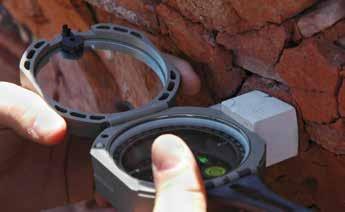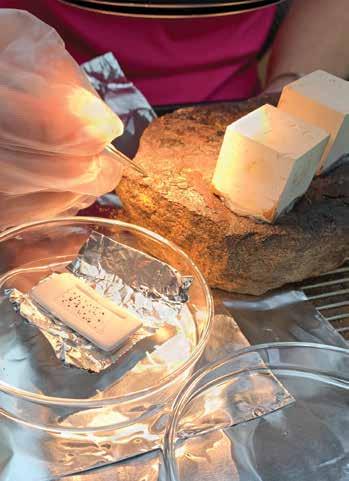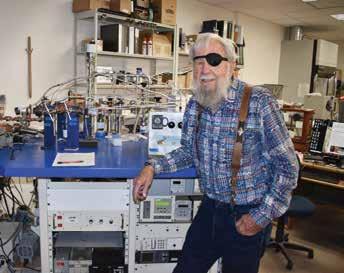
3 minute read
OFFICE OF ARCHAEOLOGICAL STUDIES
Fiscal Year Feats
$5,000
raised for exhibitions
$36,000
raised for education
$5,000
received in grants
$45,000
in endowment payouts
$56,000
raised by Friends of Archaeology
27
new client projects
182
educational programs delivered during pandemic
Office of Archaeological Studies
History is our best teacher A Year of Innovation
In the face of a global pandemic, fiscal year 2020 (July 1, 2019 to June 30, 2020) proved a challenge at the Office of Archaeological Studies. During this time, however, archaeologist-educators embraced innovation, building on the strengths of past success while adapting to a new and uncertain future.
While hands-on experiences and face-to-face interactions have been hallmarks of the Office’s award-winning educational outreach program for decades, these strengths were abruptly undercut by the risk of COVID-19 contagion. The shift to providing curriculum support for teachers and parents had already started, but circumstances forced a complete pivot. By designing and expanding curriculum to focus on topical learning modules, either distributed to families or downloaded from the web, the team implemented hundreds of educational programs statewide in the final months of FY2020.
“The relationships forged with the Community Educators Network have been key,” says Office of Archaeological Studies Director Eric Blinman, referencing the partnership with other nonprofit and educational leaders in the Santa Fe area. Ethnobotanist Mollie Toll’s experience in the network and the public school system was central to the success of adapting to new models. In addition to virtual classroom visits and Project Archaeology initiatives, the creation and distribution of stand-alone activity kits supported the hands-on and self-directed learning that parents and teachers need.
Grant support from the Museum of New Mexico Foundation was instrumental in ensuring quality programming, Blinman says. Together with individual donor gifts of $124,000, $36,000 was raised for education. After the close of the fiscal year, additional funding through a multi-year cooperative agreement with the Bureau of Land Management was announced.
“Moving into the next several years, we will have $32,000 in federal funds,” Blinman says of that partnership. “It is excellent news.”
Serving Clients Statewide
The Office of Archaeological Studies is a not-for-profit, client-based enterprise, carrying on a tradition that began in 1952. Twenty-seven new projects were initiated in FY2020, supporting clients through plans, permits, field work, analyses and reporting. Building construction projects (including the future Vladem Contemporary), roadways, pipelines, fiber-optic installations and electrical utilities were all served by staff archaeologists. Two projects span multiple fiscal years while three have an estimated service value of more than $100,000.


Top left: Dr. Marvin Rowe and the plasma oxidation system at the Center for New Mexico Archaeology. Bottom left: Collection of residue for radiocarbon dating from the surface of a Texas rock that is part of an archaeomagnetic study. Right: Field collection of archaeomagnetic dating samples from a burned wall in the Galisteo Basin. Photos courtesy Office of Archaeological Studies.

Friends of Archaeology continued their crucial support for non-client activities. Their programs (before pandemic restrictions) generated $56,000 in income, covering both the costs of fundraising and providing direct support for the Office’s staff functions. Often underappreciated is the Friends’ role in building the support that benefits valuable work in our research laboratories.
The Osteology Laboratory is home to a comprehensive computerized database of skeletal observations on age, sex, and genetic and biomechanical markers and pathologies. This resource is used by governmental and university research projects in the United States and beyond. The Archaeomagnetic Dating Laboratory continues its multi-year collaboration with the Scripps Institution of Oceanography, adding more than 5,000 magnetic field observations to the worldwide geomagnetic database. This grant-funded research collaboration will improve archaeomagnetic dating and contribute useful data to geomagnetic modeling. The Office’s diverse and talented staff of 14, including two Native American archaeologists, is at the heart of the small organization’s big success. These dedicated experts serve state, tribal, federal and private entities with services and apply their knowledge to research and education as well.
To continue providing important archaeological information for future generations, Blinman and his team rely on a generous and complex funding network, of which the Museum of New Mexico Foundation is no small part.
“The dedication of the Office of Archaeological Studies to education and research is incredible as these privately funded programs must live side by side with contract archaeological work,” says Jamie Clements, Foundation President/CEO. “Equally dedicated are the donors who support these efforts. We are happy to help make their work possible.”









